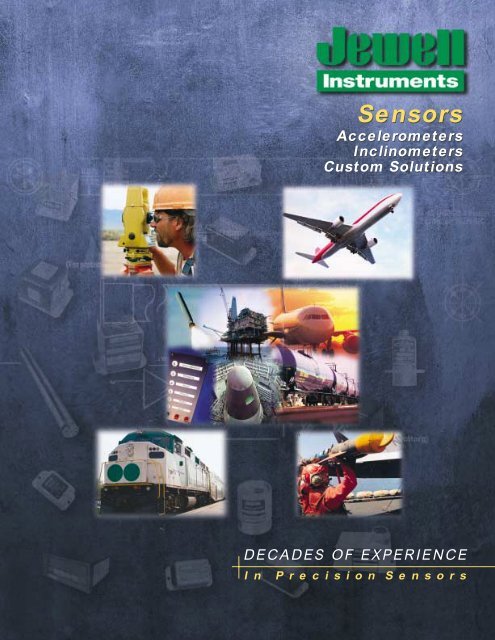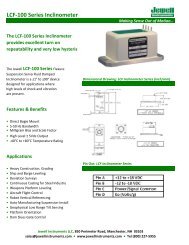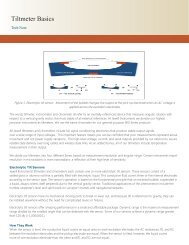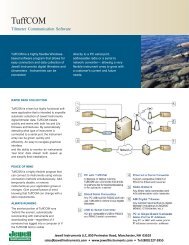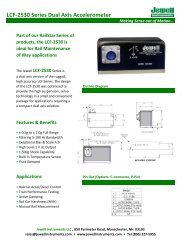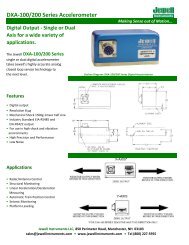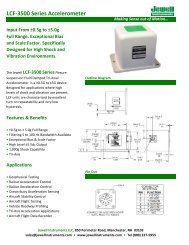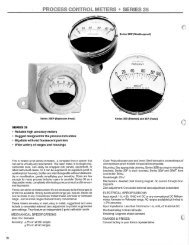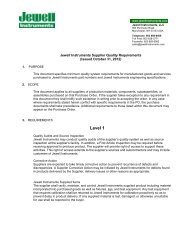Sensors Catalog - Jewell Instruments
Sensors Catalog - Jewell Instruments
Sensors Catalog - Jewell Instruments
You also want an ePaper? Increase the reach of your titles
YUMPU automatically turns print PDFs into web optimized ePapers that Google loves.
<strong>Sensors</strong><br />
Accelerometers<br />
Inclinometers<br />
Custom Solutions Custom<br />
DECADES OF EXPERIENCE<br />
I n<br />
P r e c i s i o n S e n s o r s
Highly Accurate Sensing Solutions<br />
With over forty years’ experience, <strong>Jewell</strong> <strong>Instruments</strong><br />
is a world leader in the manufacture and distribution of<br />
inertial sensors, including accelerometers and inclinometers.<br />
Well-known for both quality and reliability, <strong>Jewell</strong><br />
sensors are available for a wide range of industrial,<br />
commercial, and aerospace applications.<br />
What makes us unique is our ability to create costeffective<br />
custom solutions based on a foundation of<br />
experience and expertise built over the past four decades.<br />
Our products start where others leave off.<br />
Our high-accuracy sensors feature:<br />
■ ±1.0° to ±90° and ±0.01g to ±20g, full range<br />
■
Accelerometers<br />
All <strong>Jewell</strong> accelerometers are fully self-contained. They connect to a DC power source and a readout or control device<br />
for a complete operating system. The output is a high-level DC signal proportional to acceleration and tilt angle sine<br />
from as little as ± 0.010 g to ±20 g full range. <strong>Jewell</strong> accelerometers respond to change in velocity as small as 1µg.<br />
Hysteresis less than 0.0005% of full range output and vibration rectification less than 50 µG/G 2 are available.<br />
LCM Series<br />
A general purpose tilt sensor for industrial, commercial, and<br />
aerospace applications. Engineered with micromachined<br />
components, the LCM offers an attractive price/performance<br />
ratio. This 0.5g to 5g device meets the demanding needs of<br />
applications requiring 500g shock resistance and up to<br />
500Hz bandwidth.<br />
LSM Series<br />
The LSM Series offers features equivalent to the LCA,<br />
but in a smaller package, approximately 1” cube. Its<br />
smaller size and wide bandwidth and range make it ideal<br />
for many aerospace applications.<br />
LCA Series<br />
A 0.5g to 5g full scale acceleration sensing device with pivot<br />
and jewel suspension technology and 60Hz-250Hz bandwidth<br />
make the LCA-100 popular for a variety of military,<br />
commercial, and aerospace sensing applications.<br />
LCF Series<br />
The most rugged of all our accelerometers, the LCF-200<br />
is a compact, highly accurate, high-performance sensor<br />
with a range of 0.50g to 5g full scale; ideal for many<br />
military and rugged commercial uses. Internal electronics<br />
options feature single-ended self-test and a 2-pole output<br />
noise suppression filter.<br />
LCF-200 LCA-100 LSM LCM-100<br />
Performance<br />
Input Range, g: ±0.5 ±2.0 ±5.0 ±0.5 ±2.0 ±5.0 ±0.5 ±1.0 ±2.0 ±5.0 ±10.0 ±20.0 ±0.5 ±2.0 ±5.0<br />
Full Range Output (FRO), volts ±1% 1 : ±5.0 ±5.0 ±5.0 ±5.0 ±5.0 ±5.0 ±5.0 ±5.0 ±5.0 ±5.0 ±5.0 ±5.0 ±5.0 ±5.0 ±5.0<br />
Nonlinearity, % FRO 2 : 0.05 0.05 0.05 0.05 0.05 0.05 0.05 0.05 0.05 0.10 0.10 0.25 0.20 0.20 0.20<br />
Scale Factor, volts/g, nominal: 10.0 2.50 1.00 10.0 2.50 1.00 10.0 5.0 2.5 1.0 0.5 0.25 10.0 2.5 1.0<br />
Scale Factor Temp Sens, PPM/°C max: 100 100 100 180 180 180 200 200 200 200 200 200 0.50% reading over the temp. range<br />
Bias, g, maximum: 0.005 0.005 0.005 0.01 0.01 0.01 0.050 0.010 0.010 0.010 0.020 0.050 0.05 0.10 0.10<br />
Bias Temperature Sensitivity, µg/°C, max: 50 50 50 .100 100 100 50 50 50 100 100 200 003g/°C .003g/°C .003g/°C<br />
Natural Frequency, Hz, nominal 3 : 30 30 30 60 60 60 70 100 140 100 140 160 60 60 60<br />
Bandwidth (-3db), Hz, nominal: 30 30 30 60 60 60 70 100 140 100 140 160 60 60 60<br />
Transverse Axis Misalignment, °max: 1.0 1.0 1.0 1.0 1.0 1.0 1 1 1 1 1 1 3.0 3.0 3.0<br />
Resolution and Threshold, µg max: 10 10 10 100 100 100 10 10 10 10 20 50 0.005g 0.005g 0.005g<br />
Electrical<br />
Input Voltage, VDC: ±12 to ±18 ±12 to ±18 ±12 to ±18 ±12 to ±18<br />
Input Current, mA, nominal: 15 25 10 15<br />
Output Impedance, ohms, nominal: 100 100 10.0k 5.0k 2.5k 5.0k 2.5k 2.5k 100<br />
Noise, Vrms, maximum: 0.002 0.005 0.005 0.020 0.010 0.010<br />
Environmental<br />
Operating Temp Range: -40°C to +80°C -55°C to +85°C -55°C to +85°C -40°C to +85°C<br />
Survival Temp Range: -60°C to +90°C -65°C to +90°C -65°C to 105°C -65°C to +85°C<br />
Shock: 1000g, 1msec,1/2 sine 100g, 11msec, 1/2 sine 100g, 11msec, 1/2 sine 500g, 0.5msec,1/2 sine<br />
Vibration: 20 grms 5 grms 5 grms 10 grms<br />
Seal: Epoxy Epoxy Epoxy Epoxy<br />
Weight: 5oz. 4oz. 2 oz. 4 oz.<br />
1. Full Range is defined “from negative full input acceleration to positive full input acceleration.”<br />
2. Nonlinearity is specified as deviation of output referenced to theoretical input function value,<br />
independent of misalignment.<br />
3.<br />
Output Phase angle = -90°.<br />
3
Inclinometers<br />
<strong>Jewell</strong> inclinometers are extremely sensitive, rugged transducers designed to provide horizontal angle or<br />
vertical deviation measurements with virtually infinite resolution. Every inclinometer responds to changes of<br />
slope as small as 0.1 second of arc, with a high-level DC output signal proportional to the sine of the angle of<br />
tilt from as little as ±1° full range to ±90° full range.<br />
LCI Series<br />
Ideal for low frequency laboratory applications, the LCI<br />
Series is highly accurate, featuring a torsion flexure suspension<br />
that offers superior repeatability and low hysteresis.<br />
LSO Series<br />
Our most rugged, general-purpose, all-weather inclinometers<br />
are well-suited for a variety of commercial and industrial<br />
applications. Each casing is machined from solid aluminum.<br />
LCF Series<br />
Suitable for high-accuracy applications with high levels of<br />
shock and vibration, the LCF-100 Series uses a fluid-damped<br />
torsion flexure suspension that attenuates input energy to<br />
provide accuracy at low frequencies, even when subjected to<br />
high frequency shock and vibration.<br />
LSR Series<br />
Its compact, cylindrical shape and stackability enable several<br />
inclinometers to be used when multi-axis measuring is<br />
required. The LSR offers the same precise measurements<br />
with high outputs at lower range frequencies as our LSO<br />
Series.<br />
LSO / LSR LCI LCF-100<br />
Performance<br />
Input Range, °: ±1 ±3 ±14.5 ±30 ±90 ±14.5 ±30 ±90 ±1.0 ±14.5 ±30 ±90<br />
Full Range Output (FRO), volts ±1%: ±5.0 ±5.0 ±5.0 ±5.0 ±5.0 ±5.0 ±5.0 ±5.0 ±5.0 ±5.0 ±5.0 ±5.0<br />
Nonlinearity, % FRO 2 max: 0.05 0.05 0.02 0.02 0.05 0.02 0.02 0.05 0.05 0.02 0.02 0.05<br />
Scale Factor, volts/g, nominal: 286.5 95.5 20.0 10.0 5.0 20.0 10 5.0 286.5 20.0 10.0 5.0<br />
Scale Factor Temp Sens, PPM/°C max: 400 300 100 60 60 100 100 100 100 100 100 100<br />
Natural Frequency, Hz, nominal 3 : 0.5 2.0 15.0 20.0 40.0 5 5 5 3 30 30 30<br />
Bandwidth (-3db), Hz, nominal: 0.5 2.0 15.0 20.0 40.0 5 5 5 3 30 30 30<br />
Transverse Axis Misalignment, °max: 0.1 0.15 0.25 0.5 1.0 0.5 1.0 1.0 0.15 0.5 1.00 1.00<br />
Output at 0° Tilt, volts, maximum: 0.1 0.04 0.02 0.02 0.02<br />
0° Output Temp Sensitivity, volts/°C, max: 0.005 0.003 0.001 0.0005 0.0003<br />
Bias, volts max: 0.050 0.050 0.025 0.500 0.100 0.100 0.050<br />
Bias Temp Sensitivity, volts/°C max: 0.0005 0.0005 0.0003 0.015 0.001 0.0005 0.0003<br />
Resolution and Threshold, µradian: 1 1 1 1 1 1 1 1 1 1 1 1<br />
Electrical<br />
Input Voltage, VDC: ±12 to ±18 ±12 to ±18 ±12 to ±18<br />
Input Current, mA, nominal: 15 25 15<br />
Output Impedance, ohms, nominal: 100 100 100<br />
Output Impedance, LSR: 15k 5k 16k 8k 4k<br />
Noise, mV rms, maximum: 0.002 0.0005 0.002<br />
Environmental<br />
Operating Temp Range: -20° C to +71°C -55° C to +85° C -40° C to +85° C<br />
Survival Temp Range: -40°C to +71°C -60° C to +90° C -60° C to +90° C<br />
Shock: 1500g, 0.5msec, 1/2 sine 100g, 11msec, 1/2 sine 1000g, 1msec, 1/2 sine<br />
Vibration: 20 grms 1 grms 20 grms<br />
Weight: 13.0 oz. 3.0 oz. 5.0 oz.<br />
1. Full Range is defined “from negative full input angle to positive full input angle.”<br />
2. Nonlinearity is specified as deviation of output referenced to theoretical sine function value, independent of misalignment.<br />
3.<br />
Output Phase angle = -90°.<br />
4
Inclinometers<br />
LCF-196 Biaxial<br />
The LCF-196 inclinometer provides a biaxial<br />
output in a 23mm diameter package. It is a high<br />
accuracy sensor designed for applications where<br />
high levels of shock and vibration are present. The signal is<br />
typically input to analog or digital data recording systems.<br />
4 to 20 milliamp<br />
output LSO<br />
This LSO inclinometer is designed for applications where<br />
high levels of ambient electrical noise are present and/or<br />
long cable runs are required.<br />
LCF-2000 Biaxial<br />
The two axis version of the rugged, high accuracy LCF-100<br />
is available with a wide range of options including single<br />
ended input power, an internal temperature sensor, and 4 to<br />
20 milliamp output.<br />
LCA-100, LCF-100, LCF-200,<br />
and LCM Series<br />
Digital Display<br />
AIR-1000 Inclinometer Angle Readout<br />
The AIR-1000 is a microprocessor-based panel meter that<br />
displays the trigonometric output of a <strong>Jewell</strong> gravity referenced<br />
inclinometer as an angle equivalent with 0.001°<br />
resolution. The 120VAC input AIR-1000 provides ±15 volt<br />
sensor power and an RS-232 digital output.<br />
LCI<br />
LSR<br />
LSOC/P<br />
5
Digital Inertial Sensor<br />
The LDF series digital inclinometer takes <strong>Jewell</strong> <strong>Instruments</strong>’<br />
highly accurate and robust force balanced technology to the<br />
next level. <strong>Jewell</strong>’s LDF series digital inclinometer is available<br />
with an RS-422 serial interface. Its onboard processor allows<br />
the LDF series inclinometer to compensate<br />
for errors, including temperature,<br />
ensuring the highest level of accuracy<br />
over the entire operational temperature<br />
range of the sensor. The LDF series<br />
features a wide input power supply<br />
range of 6 to 50VDC and customizable<br />
LDF-1600<br />
bandwidth from DC to over 100Hz<br />
making it extremely versatile. This<br />
advanced sensor comes standard with a -5 to +5VDC analog<br />
output for operation with systems requiring analog input.<br />
<strong>Jewell</strong> provides this advanced sensor in a rugged, sealed<br />
package. <strong>Jewell</strong> does it once again, providing this advanced,<br />
high accuracy and robust solution for your tilt sensing<br />
problems. There is nothing else in its class.<br />
Features:<br />
■ ±90º (±1g) Full Range<br />
■ RS-422 serial interface<br />
■ Wide input power supply range from 6 to 50VDC<br />
■ Outstanding resolution<br />
■ Customizable bandwidths from DC to 100Hz<br />
■ Includes standard –5 to +5VDC analog output<br />
■ Advanced temperature compensation ensures high<br />
accuracy over a -40°C to +80°C temperature range<br />
■ Proprietary protocol contains advanced forward error<br />
correction and error detection<br />
■ Rugged, sealed package with a military subminiature<br />
cylindrical connector that is scoop-proof and has a<br />
bayonet lock coupling<br />
6
Custom-Engineered Solutions<br />
<strong>Jewell</strong> specializes in custom-designed, high-accuracy,<br />
inertial sensing solutions. Our sensors solve unique<br />
application problems where standard, off-the-shelf<br />
sensors simply won’t do. More companies choose<br />
custom-engineered <strong>Jewell</strong> tilt sensors because of:<br />
■ Our high-value, high-accuracy, rugged designs<br />
■ Our willingness and capability to design and engineer<br />
custom solutions based on our proven methodologies<br />
■ Our applications expertise enabling us to understand<br />
what will work, what won’t work, and what the trade-offs<br />
will be in virtually any design<br />
For many aerospace and industrial applications, our<br />
sensors are the perfect custom solution. Here are several<br />
inertial sensor application challenges and our customengineered<br />
solutions to them:<br />
Railcar Control<br />
Acceleration and deceleration control is critical in railcars<br />
and people movers. The input dynamics of these systems are<br />
constantly changing as people board and disembark. Accelerometers<br />
measure the inputs for speed-control systems that<br />
adjust vehicle acceleration resulting in a safe and comfortable<br />
ride.<br />
Our LCF-200-2g has been custom-engineered to meet the<br />
special demands of railcar control. A customized frequency<br />
response system meets the demands of the unique dynamics<br />
encountered in railcar applications. This sensor includes<br />
ruggedized electrical components to ensure durability for this<br />
demanding application.<br />
Flight Control<br />
Flight control systems make many routine adjustments<br />
to attitude and direction in the course of a flight using<br />
accelerometers. Flight control accelerometers require high<br />
accuracy, high reliability and must conform to aircraft<br />
standards such as 28V unipolar inputs.<br />
The g-limiter is a complete system operating from<br />
28VDC input, including a DC/DC converter, a highaccuracy<br />
servo accelerometer, and a comparator. The system<br />
output is a measured change in output-state. It is derived<br />
from the relationship between the input acceleration and<br />
internal reference acceleration. Application specific signal<br />
conditioning and redundant systems are built into each unit.<br />
The LCA-165/167 are high performance<br />
pivot and jewel 5g and 10g accelerometers<br />
used in autopilot applications. The output<br />
of the LCA-165/167 is electrically isolated<br />
from the input power.<br />
The LSXF is the custom solution of choice for aircraft<br />
stability and control applications. The LSXF is a low-range<br />
accelerometer with milli-g accuracy in the presence of<br />
20grms vibration. Its mechanical input-energy attenuation<br />
and unique servo characteristics yield<br />
a high accuracy. Rugged features<br />
include a solid aluminum machined<br />
housing and specially encapsulated<br />
electronics ensuring components<br />
remain intact regardless of external<br />
forces. EMI/RFI filtering is included.<br />
Missile<br />
Today’s smart weapons rely on integrated missile guidance<br />
systems to deliver strikes accurately and in some cases evade<br />
enemy early detection systems. Accelerometers are an<br />
essential component of these systems – collecting input data<br />
to determine if the missile is on course and delivering that<br />
data to a guidance control system so that the missile can<br />
reach its intended target.<br />
The rugged LCA-215 unit delivers accurate<br />
information in a high-vibration environment.<br />
A specially engineered servo loop includes<br />
frequency rejection, enabling accurate output<br />
of 0 to 10g acceleration in the midst of high<br />
vibration and acoustic noise.<br />
7
Custom-Engineered Solutions<br />
Antenna Orientation<br />
Custom force balance inclinometers are employed in<br />
many fire control systems and mobile antenna leveling<br />
applications. They accurately measure slope and tilt of the<br />
installation enabling automated leveling of a weapon’s<br />
platform or target acquisition radar.<br />
The LCF-2310 is a biaxial accelerometer<br />
used in a variety of fire control<br />
applications. This ruggedized unit produces<br />
a highly accurate, low noise output with a<br />
low pass filtered bandwidth. EMI/RFI<br />
filtering is also included.<br />
Ship and Barge Leveling<br />
Signals from an inclinometer installed on a ship or<br />
barge are sent to a ballast transfer hydraulic system. The<br />
inclinometer is also employed for closed-loop leveling of<br />
equipment in underwater drilling and mining operations.<br />
The LCF-2450 has infinite resolution and high sensitivity<br />
for very high accuracy and level control. Its rugged design<br />
features a machined aluminum, all-weather housing.<br />
Deviation Surveys<br />
Used for borehole mapping and deviation surveys, our<br />
inclinometers respond to borehole deviations as small as<br />
0.1 second of arc.<br />
Angular Acceleration<br />
Accelerometers contribute in a variety of angular acceleration<br />
functions. <strong>Jewell</strong> application engineers excel at providing<br />
custom solutions for flight control systems such as autopilot<br />
or aircraft stability and control systems or<br />
satellite stability.<br />
Our ASXC-100 is a rugged, fluid-rotor<br />
angular accelerometer, sensitive to very<br />
small angular acceleration. A fluid rotor<br />
enables high sensitivity without relying on<br />
a large mass supported by a fragile bearing<br />
system. This rugged design enables the<br />
Full scale ranges of<br />
ASXC-100 to respond to tiny angular 1 radian/sec 2 to<br />
±100 radians/sec<br />
inputs. Available in ranges from 1 radian/<br />
2<br />
second 2 to 100 radians/second 2 full scale.<br />
The ASBC angular accelerometer is a<br />
general purpose device made for industrial,<br />
commercial and aerospace sensing<br />
requirements. Its many applications<br />
include antenna stabilization, torque<br />
measurement, flight control systems,<br />
Full scale ranges of<br />
200 radians/sec 2 to<br />
±1000 radians/sec 2<br />
automotive testing, and optical system<br />
stabilization.<br />
8
Analog Principles of Operation<br />
<strong>Jewell</strong> accelerometers and inclinometers are precision<br />
inertial instruments. They utilize closed loop sensor<br />
technology to produce a highly accurate output at a relatively<br />
low price for the specified performance. The inertial sensor<br />
output is an analog voltage proportional to applied acceleration<br />
and tilt from DC through a specified frequency.<br />
Note that an accelerometer and an inclinometer are the<br />
same device. The distinction is one of application, not<br />
operation. Accelerometer users typically sense changes in<br />
velocity and characterize outputs and errors in g. Inclinometer<br />
users sense changes in angular position and think of<br />
outputs and errors in units of angular measurement. <strong>Jewell</strong><br />
inertial instruments respond to both earth’s gravity and<br />
acceleration.<br />
The sensing element in a <strong>Jewell</strong> inertial instrument is the<br />
torquer, a D’Arsonval mechanism designed specifically for<br />
sensor use. <strong>Jewell</strong> has produced inertial instrument torquers<br />
and complete acceleration sensing assemblies for many years.<br />
Hundreds of thousands of acceleration sensors have been<br />
manufactured. <strong>Jewell</strong> sensors are used throughout the world<br />
for detecting acceleration and tilt from less than one µg (one<br />
µRadian) to more than 50g.<br />
The torquer mechanism is typically the most expensive<br />
subassembly in a servo sensor. Torquers are sophisticated<br />
meter movements, and <strong>Jewell</strong>, as a meter manufacturer,<br />
can produce torquers very efficiently. We, therefore, often<br />
have a cost advantage when compared to other conventional<br />
technology inertial instrument producers.<br />
A torquer used to sense acceleration or tilt is intentionally<br />
unbalanced in its plane of allowable angular motion. When<br />
acceleration or tilt is present, a torque proportional to the<br />
mechanism unbalance and the physical input is developed.<br />
The torque results in an angular motion sensed by a position<br />
detector. The position detector output is compared to a<br />
reference voltage, and the difference is an error signal that is<br />
the input to a servo amplifier. The servo amplifier output<br />
current is applied to the torquer in opposition to the<br />
acceleration or tilt torque. At a constant inertial input, the<br />
torquer mechanism angular position is minutely different<br />
from the zero g position. The servo amplifier output current<br />
is directly proportional to the applied acceleration or sine of<br />
the input tilt angle. An analog voltage is produced by<br />
measuring the servo current with a sense resistor.<br />
9
Understanding the Specifications<br />
The following information describes how <strong>Jewell</strong> <strong>Instruments</strong><br />
interprets performance characteristics and error<br />
sources often listed in inertial instrument specifications.<br />
The <strong>Jewell</strong> interpretation is generally consistent with IEEE<br />
accelerometer test conventions.<br />
Range and Scale Factor<br />
The range of an accelerometer or inclinometer is the input<br />
from + to - over which the transducer is expected to yield the<br />
specified output. A ±2g accelerometer has an input range of<br />
4g. The scale is one half the range, 2g in the example given.<br />
<strong>Jewell</strong> inertial sensors operating at ±15 volt bipolar input<br />
voltage have an operating overrange capability of 50% to<br />
100%. A 30° inclinometer, for example, will operate without<br />
meaningful performance degradation to 90°. The sine of 90°<br />
(1.00) being twice the sine of 30° (0.50). Beyond 100%<br />
overrange, the output voltage will begin to clip. The<br />
overrange capability for unipolar input power units is<br />
typically limited to less than 25% by the available input<br />
or output voltage. Units with 4-20mA output are limited by<br />
the voltage to current converter at less than 5% overrange.<br />
Natural Frequency and Damping<br />
The accelerometer or inclinometer dynamics can be treated<br />
as second order for most <strong>Jewell</strong> designs.<br />
The natural frequency is the frequency at which the phase<br />
of the accelerometer or inclinometer output lags the input<br />
by 90°.<br />
The bandwidth of an accelerometer or inclinometer is<br />
defined as the frequency range below the frequency at which<br />
the amplitude of the output is 3dB down relative to the<br />
input.<br />
Bias<br />
The bias is the accelerometer output when no acceleration<br />
is applied. Bias results primarily from residual suspension<br />
torque. The output from a stationary accelerometer or<br />
inclinometer on a flat surface is a combination of bias,<br />
misalignment and noise. Some data sheets specify unit<br />
output on a horizontal surface as Output at Zero Tilt.<br />
Output at Zero Tilt is the combined output axis<br />
misalignment and bias.<br />
Input Axis Misalignment<br />
The input axis misalignment is the geometric sum of<br />
the pivot (output) axis and pendulous axis misalignments<br />
relative to the base and a reference side of the accelerometer.<br />
The standard alignment is a function of sensing range. The<br />
alignment specification in the data sheets is the maximum<br />
misalignment of either (or both) transverse axes.<br />
Cross axis acceleration or tilt is sensed by an inertial<br />
instrument as a function of the sine of the misalignment<br />
angle.<br />
Nonlinearity<br />
Nonlinearity is the largest deviation in the accelerometer<br />
output curve over its specified input range when the output<br />
is compared to a least squares best fit straight line.<br />
Resolution and Threshold<br />
Threshold is the smallest input change that will result<br />
in a meaningful (50% of expected) output change at zero.<br />
Resolution is the smallest input change anywhere in the<br />
operating range that will result in a meaningful output<br />
change. Resolution and threshold errors are not always the<br />
same for accelerometers and inclinometers. The resolution<br />
of many standard units is, in fact, infinitely small.<br />
Repeatability<br />
Repeatability defines an area of output uncertainty<br />
within which the sensor may yield different outputs for<br />
identical inputs. The uncertainty is usually a function of<br />
moving system suspension friction and position errors.<br />
Flexure suspension units have relatively small repeatability<br />
errors. Pivot and jewel units can have 0.001g to 0.005g of<br />
uncertainty. Observed repeatability is application dependent.<br />
Pivot and jewel units have better than expected “real life”<br />
repeatability when some vibration is present. The vibration<br />
energy helps reduce the effect of bearing friction.<br />
Noise<br />
Noise is the dynamic output from the accelerometer<br />
when no acceleration input is present.<br />
10
Understanding the Specifications<br />
Input Voltage<br />
The input voltage specified is the range of voltages over<br />
which the unit is expected to operate within specification. If<br />
the input voltage is increased beyond the specified range, an<br />
accelerometer or inclinometer will continue to operate. At<br />
higher input voltages, additional current is required. The<br />
internal heat dissipation increases, and component life begins<br />
to decrease. Most units will also continue to operate at input<br />
voltages below the specified range. The output voltage<br />
clipping level and overrange capability are decreased at<br />
lower input voltages.<br />
Alternate input power choices including 5 volts,<br />
12 volts and 28 volts single ended as well as ±5 volts<br />
bipolar are available.<br />
Input Current<br />
The input current is the current the accelerometer or<br />
inclinometer will draw from a power supply at the specified<br />
nominal operating voltage. For bipolar input units, the<br />
positive and negative currents are not necessarily balanced.<br />
It is possible to reduce the current requirement, but<br />
applications must be evaluated on an individual basis.<br />
Output Impedance<br />
The standard output configuration is an operational<br />
amplifier with 100 ohms in series with the output. Other<br />
configurations including direct output across the load<br />
resistor, or use of an external load resistor, are possible.<br />
Operating Temperature Range<br />
The operating temperature range defines the temperature<br />
extremes over which the accelerometer or inclinometer<br />
will work without temperature induced failure or a permanent<br />
change in some output characteristic. A unit will<br />
continue to operate at temperatures somewhat higher<br />
or lower than stated in the standard specifications, but<br />
damage is likely.<br />
Survival Temperature Range<br />
The survival temperature range defines the temperature<br />
extremes a unit can be exposed to without damage when it is<br />
not powered.<br />
Shock and Vibration<br />
Shock indicates the highest shock level that the accelerometer<br />
or inclinometer can be exposed to without damaging<br />
the unit. The specified shock cannot be applied an infinite<br />
number of times.<br />
Random vibration limits are specified for 3-hour<br />
exposure to white noise in the bandwidth 20Hz to 2000Hz.<br />
The highest continuous acceleration level that can be<br />
applied without damage is typically 30g, but must be<br />
evaluated on an individual application basis if constant<br />
acceleration greater than 10g is present.<br />
Seal<br />
Sealing specifies the design technique selected to prevent<br />
moisture, dust, or other external contaminant from entering<br />
the sensor housing.<br />
11
Facilities<br />
We offer two, fully modernized manufacturing facilities in Manchester, New Hampshire and<br />
Barbados, West Indies. Both are fully capable of handling the most stringent manufacturing<br />
requirements while our Barbados facility also provides the extremely cost-competitive<br />
advantage of an offshore manufacturer.<br />
Manchester, New Hampshire<br />
■ 60,000 square foot headquarters facility features R&D,<br />
engineering, and manufacturing personnel dedicated to <strong>Jewell</strong>’s<br />
products and Partnership Manufacturing<br />
■ Located at Manchester Airport, one hour north of Boston<br />
Barbados, West Indies<br />
■ 30,000 square foot offshore manufacturing facility<br />
features a dedicated <strong>Jewell</strong> team experienced at providing<br />
low-cost, high-quality manufacturing<br />
Products<br />
Meters<br />
A complete selection of panel meters for virtually every use, from simple<br />
analog power meters to complex selectable-function digital meters<br />
Solenoids<br />
High performance, cost-effective frame<br />
and tubular solenoids<br />
Avionics<br />
Indicators and instrumentation for aviation,<br />
including complete instrument clusters<br />
Partnership Manufacturing<br />
Precision sub-assemblies and complete products manufactured to order for<br />
a wide range of industrial, commercial, avionic, and military applications<br />
<strong>Jewell</strong> <strong>Instruments</strong>, LLC<br />
850 Perimeter Road, Manchester, NH 03103 USA<br />
Tel. 603-669-6400 • Fax 603-669-5962<br />
Toll Free 800-METERS-1 • 800-638-3771<br />
sales@jewellinstruments.com • www.jewellinstruments.com


